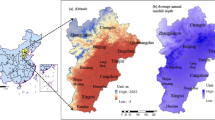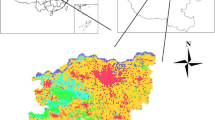Abstract
Regional waterlog disaster integrated risk system, affected by natural, social, and economic systems and its combination relationship, is a complex system with certain structure and function. Waterlog disaster integrated risk results from the combined effects of regional environment, impact factors, vulnerability, and disaster-reducing capability of flood hazards in the drainage area. Waterlog disaster integrated risk system can be divided into four subsystems of hazard, vulnerability, disaster-reducing capability, and disaster conditions. Evaluation indexes are selected using fuzzy analytic hierarchy process method, and the evaluation index system is established. Then, the waterlog disaster integrated risk evaluation model is proposed based on set pair analysis method. Taking Huaihe river in Anhui Province of China as the typical area in this study, the results show that the proposed approach is able to obtain the spatial distribution characteristics of waterlog hazard, vulnerability, mitigation capabilities, and integrated disaster risk within the study area. From the quantitative point of view, identification of the areas with high flood risk can provide a scientific basis for the flood management and technical support.





Similar content being viewed by others
References
Bayraktar H, Bayram B (2009). Fuzzy logic analysis of flood disaster monitoring and assessment of damage in SE Anatolia Turkey. In: The 4th International Conference on Recent Advances in Space Technologies, pp 13–17
Chen SY (2005) Water resources and flood control system of variable fuzzy set theory and method. Dalian University of Technology Press, Dalian
Chen SY, Guo Y (2005) Comprehensive evaluation of water quality based on variable fuzzy sets method. Water Conserv Mag 12(24):19–22
Cheng QS (1997) Set of attributes and attribute comprehensive evaluation system[J]. Syst Eng Theory Pract 9:15–23
Fu J, Jin JL, Wang ZZ (2010) Based on dynamic combination of the weight of Set Pair Analysis of vulnerability assessment model of water resources. Zhao Keqin editor of the non-traditional security and set pair analysis. Intellectual Property Publishing House, Beijing
Harikishan J, Gregory J. H, Chris F, et al (2014). A probabilistic approach to assess agricultural drought risk to maize in southern Africa and millet in Western Sahel using satellite estimated rainfall. Int J Disaster Risk Reduct. 10.1016/j.ijdrr.2014.04.002
Harry S, Downes Nigel K (2011) A scenario-based approach to assess Ho Chi Minh City’s urban development strategies against the impact of climate change. Cities 28(6):517–526
Huang CF (2005) The ladder structure of comprehensive risk management. J Nat Disasters 14(6):8–14
Jin JL, Wei YM (2008) The generalized intelligent evaluation and applications of complex systems. Science Press, Beijing
Jin JL, Hong TQ, Wang WS (2007) Fuzzy comprehensive evaluation model based on entropy and FAHP water resources sustainable utilization. J Hydroelectr Eng 26(4):22–28
Jin JL, Wu KY, Wei YM (2008) Based on coefficient number River basin water security evaluation model. Hydraul Eng 5(13):401–409
Kawano N, Shimada M (2009) Flood disaster monitoring with ALOS/PALSAR observation. Geosci Remote Sens Symp IEEE Int IGARSS 4:641–644
Li FX, Xin Y, Chen W (2000) Set pair analysis for the evaluation of lake eutrophication study. Chongqing Environ Sci Mag 22(6):10–11
Meng XM, Hu HP (2009) Based on entropy weight set pair analytical model in comprehensive evaluation of water quality. Hydraul Eng 40(3):257–262
Pedro PDS, Alexandre OT, Zêzerec JL (2014) Risk analysis for local management from hydro-geomorphologic disaster databases. Environ Sci Policy 2:1–16
Shi PJ (1991) The statement of disasters research theory and practice. J Nanjing Univ 11:37–42
Shi PJ (1996) The further statement of disasters research theory and practice. J Nat Disasters 5(4):6–17
Shi PJ (2002) The statement of disasters research theory and practice thirdly. J Nat Disasters 11(3):1–9
Shi PJ (2005) The statement of disasters research theory and practice fourthly. J Nat Disasters 14(6):1–7
Song RP (2009) Simulation and evaluation of regional water security based on system dynamics. Hefei University of Technology, Hefei
Tomoaki N, Takeyoshi T, Akihiko H (2012) An evaluation method for the urban post-earthquake fire risk considering multiple scenarios of fire spread and evacuation. Fire Saf J 54:167–180
Wang XF (2006) Coal ash slagging characteristics based on attributes mathematics and coefficient mathematics comprehensive evaluation model and application. Boiler Technol 37(6):47–50
Wang YZ, Ye NJ (2007) The drainage problems of farmland of Huaibei plain, Anhui Province. Anhui Agric Sci 14(158):4389–4391
Xu YC, Wu YS (2007) The cause analysis of Huaihe river flood disasters in Anhui province. Harness Huai River 4(4):11–16
Zhang YC (1998) The comprehensive prediction of China’s natural disaster and the measures of partition risk mitigation. Geol Hazard Environ Prot 9(1):1–5
Zhao KQ (2000) Sets pair analysis and its preliminary application. Zhejiang Science and Technology Press, Hangzhou
Zheng J C (2010). Simulation and analysis of effect on urban operation of urban storm waterlogging. In: 2nd International Conference on Advanced Computer Control (ICACC), 2010. (2):385–389
Zheng W, Liu C, Xin ZB, Wang ZX (2008) Flood and waterlogging monitoring over Huaihe River Basin by AMSR-E data analysis. Chin Geogr Sci 18(3):262–267
Zou LL, Jin JL, Zhou YL (2010) Filtration model of integrated risk assessment index system of reservoir induced seismicity based on fuzzy analytic hierarchy process and accelerating genetic algorithm. Seismic Geol J 32(4):628–637
Acknowledgments
The authors gratefully acknowledge the financial support from the National Natural Science Foundation of China (NSFC) under Grant Nos. 71020107026 and 71273081; SRFDP under Grant No. 20091101110044; and Anhui Provincial Natural Science Foundation under Grant No. 1208085ME75.
Author information
Authors and Affiliations
Corresponding author
Rights and permissions
About this article
Cite this article
Jin, JL., Fu, J., Wei, YM. et al. Integrated risk assessment method of waterlog disaster in Huaihe River Basin of China. Nat Hazards 75 (Suppl 2), 155–178 (2015). https://doi.org/10.1007/s11069-014-1307-0
Received:
Accepted:
Published:
Issue Date:
DOI: https://doi.org/10.1007/s11069-014-1307-0




